![]()
![]()
![]()
Use LEFT and RIGHT arrow keys to navigate between flashcards;
Use UP and DOWN arrow keys to flip the card;
H to show hint;
A reads text to speech;
6 Cards in this Set
- Front
- Back
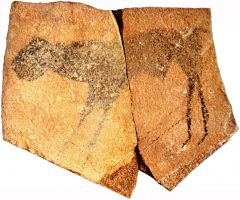
Apollo Stone |
Namibia, Africa Paleolithic 25,500 BCE Charcoal on Stone - schematic representation: icon, simplified representation - art style: animal figures in silhouette profile - large utters= concerned with the fertility of animals, indicate a record of food source - found with many of the same images= suggests a possible ritualistic use |
|
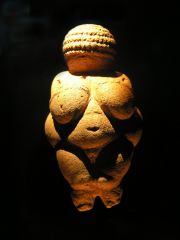
Venus of Willendorf |
Willendorf, Austria Paleolithic 25,000 BCE Carved Limestone - voluptuous women * depiction of women were more common than men - women were focused on childbearing capabilities and survival of the species - exaggerated and abstract, simple, round/bulbous form - focus on large breasts and round proportions also with hands on breasts focusing on fertility. - schematic representation: simplest form, no facial features= no individualis (for anyone) - small size= portable |
|

Great Hall of Bulls, Lascaux Caves |
Lascaux, France Paleolithic 14,000 BCE Rock painting - mineral pigments - painted caves with the use of fat lit lamps - a herd of horses and bulls - multiple styles= contour and silhouttes, outlines - profile view: schematic representation - twisted perspective; horns face as if they are looking straight at us, but bodies are sideways - maybe religious bc or placement? |
|
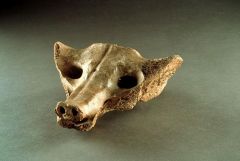
Camelid sacrum in the shape of a canine |
Central Mexico 14,000 BCE Sacrum bone of camelid - bone next to the reproductive organs, important for the species. - The sacrum is sacred in some indigenous societies - most likely used as a mask for ritual od fertility of heard and success of the hunt |
|
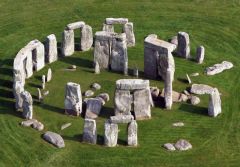
Stone Henge |
Wiltshire, England Neolithic 2,000 BCE - Megalithic sandstones and volcanic rock - concentric cirlces made of post and lintel constructions - 1st inner circle: made of volcanic rocks or bluestone, encircled a horseshoe shape of trilithons (5) - Heel stone stands outside marking the point where sun rises during the summer solstice - An example of how people tried to influence and integrate with the natural cycles of the cosmos to promote the human existence - originally a funerary site then as an astronomical observatory and solar calendar. |
|
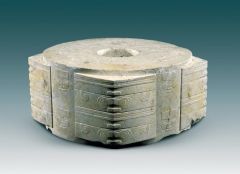
Jade Cong |
Liangzhu, China Neolithic 3,300 BCE Carved jade - ritual objects were created in jade - cong= square, hollow tubes decorated with lines and circles that represent faces - found in graves - lines and circles made by rubbing sand - square interior=earth |

